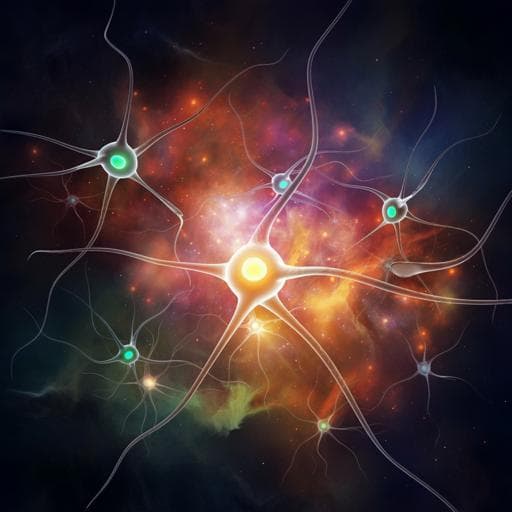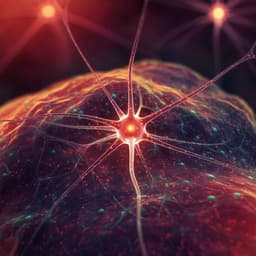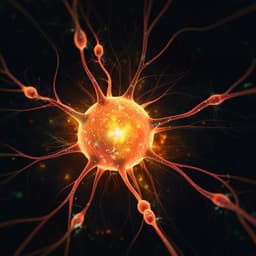
Medicine and Health
A brain cell atlas integrating single-cell transcriptomes across human brain regions
X. Chen, Y. Huang, et al.
Discover the groundbreaking Brain Cell Atlas, a pivotal resource crafted by Xinyue Chen and colleagues. This atlas synthesizes a vast array of brain cell data from 70 human and 103 mouse studies, unveiling novel cell types and gene regulatory differences that could reshape our understanding of brain functions and diseases.
~3 min • Beginner • English
Introduction
The study addresses the need for a unified, large-scale reference of human brain cell types spanning diverse regions, developmental stages, and conditions to resolve heterogeneity and identify rare cell populations. Prior single-cell studies have advanced neuronal taxonomy but often focus on single regions or specific diseases, leaving cross-regional variation and rare states underexplored. By integrating atlas-level data, the authors aim to uncover rare neural progenitor cells in adults and characterize microglial diversity and regional heterogeneity, improving our understanding of neurogenesis, microenvironmental influences, and disease-related phenotypes.
Literature Review
Large consortia (Human Cell Atlas, HuBMAP, BICCN, Allen Brain Atlas) have produced extensive brain single-cell datasets. Tasic et al. showed area-specificity in glutamatergic neurons with shared nonneuronal and many GABAergic types across cortical areas (mouse). Siletti et al. profiled 3.3M adult human brain nuclei across regions, and Braun et al. mapped first-trimester human brain development with 1.6M cells into 616 clusters. Existing studies often focus on single regions or conditions, limiting discovery of rare cells and regional heterogeneity. Integrative analyses have potential to reveal neurogenesis across ages, rare cell types, and contributions to neurodegenerative diseases.
Methodology
Data collection and curation: The Brain Cell Atlas aggregates single-cell/nucleus RNA-seq from 70 human and 103 mouse brain studies (>1,800 datasets) sourced from GEO, UCSC Cell Browser, ArrayExpress, Allen Brain Map, Synapse, CELLXGENE, and other portals. Raw counts were converted to AnnData (h5ad) and metadata were manually harmonized (fields include cell/sample IDs, region hierarchy, sequencing method, donor demographics and status, original annotations). Quality control removed cells with <200 counts, doublets (Scrublet score >0.3), and high mitochondrial content (>10%) when original annotations were absent, and doublet-labeled cells were excluded when annotations were present.
Reference-based annotation: Datasets were grouped (adult, fetal, organoid, tumor) and reannotated using eight supervised ML methods (ACTINN, scArches, CHETAH, scmap, SingleCellNet, SingleR, scPred, scAnnot). Two references guided label transfer: adult (Siletti et al., ~3.3M nuclei across whole brain) and fetal (Braun et al., 1.6M cells). A consensus cell type per cell was assigned by majority vote; otherwise labeled 'unannotated'. Differential expression used Seurat FindMarkers (Wilcoxon) on consensus cell types.
Hierarchical annotation (scAnnot): The authors developed scAnnot, a hierarchical workflow built on scANVI/scVI. First-level models classify 31 primary cell classes using 1,841 DE-derived genes; second-level models refine subtypes within classes. Models were optimized across latent dimensions, network layers, and seeds, employing transfer learning from scVI to scANVI and early stopping. Accuracy was evaluated via confusion matrices and Silhouette scores for batch effects; most first-level accuracies exceeded 93% (average 98%), and second-level accuracies were 90% (training) and 83% (validation).
Integration and visualization: scANVI latent embeddings and UMAP were used for atlas-scale integration; Harmony was used in specific cross-species analyses. Batch covariates (sample_ID, species) were modeled in latent space.
Adult hippocampal neurogenesis (AHN) analysis: Human hippocampus datasets spanning fetal, infant, child, and adult were integrated with mouse developmental hippocampus data using 13,596 orthologous genes. PCA on 2,000 HVGs (mouse) followed by Harmony batch correction (species, sample ID) yielded a shared latent space. Logistic regression trained on mouse labels inferred human cell identities, then refined by marker genes (NPCs: MKI67, TOP2A; neuroblasts: DLX2, SOX11; immature glutamatergic: SOX11, PROX1; glutamatergic neurons: PROX1, PLEKHA2; CA neurons: SLC17A7, COL5A2; GABAergic: GAD1/2; astrocytes: GFAP, AQP4; endothelial: FLT1, ENG; OPCs: PDGFRA, OLIG1; NFOLs: OLIG2, SOX10; oligodendrocytes: MOG, MAG). NPC gene module scores were computed from conserved NPC markers (TOP2A, HMGB2, PBK, UBE2C, RRM2, CDCA3, CCNA2, TPX2); putative NPCs were defined by score ≥3. Pseudotime (DPT) and RNA velocity (scVelo) inferred trajectories from putative NPCs towards astrocytes and mature neurons. Immunostaining validated ASCL1/MKI67 coexpression in adult human DG; macaque DG showed SOX2/MKI67 in SGZ.
Microglia PCDH9high identification and regional analysis: Integrated adult human prefrontal cortex and hippocampus datasets (43 samples; 511,872 cells; 12 primary cell types) were subset to microglia, revealing a PCDH9high microglia population. DEGs and gene set scoring (Sun et al. microglial states) placed PCDH9high cells between homeostatic and inflammatory II states. GO/KEGG enrichment (clusterProfiler) and GSEA indicated roles in axon guidance, endocytosis, synapse/axon development. Immunostaining confirmed SPP1+ PCDH9+ microglia containing MAG signal in hippocampal DG and prefrontal cortex, consistent with myelin debris phagocytosis. Regional DE between hippocampus and prefrontal cortex modeled covariates via pseudobulk edgeR GLMs (donor age/sex when donor ID confounded). Hippocampal PCDH9high microglia showed synaptic plasticity associations (NRXN1, GRIK2, HOMER1; glutamate receptors GRIA2, GRIK2/3), while prefrontal PCDH9high showed phagocytic/antigen presentation (C3, PLCG2; MHC-II; CD74, TLR2, SYK) and complement components (C1QA/C1QC) upregulation.
Cell-cell communication: CellChat inferred ligand-receptor interactions across 60 pathways (45 conserved, 12 prefrontal-specific, 3 hippocampal-specific). Hippocampal PCDH9high microglia exhibited specific signaling changes in NRG, CADM, NEGR, and laminin pathways. Notable glutamatergic neuron-to-microglia interactions included LAMB1–ITGB8; microglia-to-neuron interactions included LAMA1–SV2B, LAMA2–(ITGAV+ITGB8), and LAMA2–(ITGA7+ITGB1).
Differential expression modeling: To account for batch/technical effects, counts were aggregated to pseudobulk per sample (Libra) and tested with edgeR GLMs including covariates (e.g., donor_ID; or donor age/sex when donor_ID confounded). Visualization used EnhancedVolcano. Functional enrichment used Enrichr and MSigDB gene sets; state/function scoring used gssnng.
Key Findings
- Constructed the Brain Cell Atlas integrating 26.3 million cells/nuclei: 11.3M human (70 studies; 6,577 samples; 14 main regions, 30 subregions) and 15M mouse (103 studies; 25,710 samples). Human sample types: adult (8,062,832), fetal (2,203,728), organoid (861,169), tumor (234,295). 94.8% sequenced by 10x Chromium.
- Consensus cell type annotation using eight ML methods and hierarchical scAnnot yielded 32 primary clusters; first-level scAnnot accuracy averaged 98%, second-level accuracies 90% (training) and 83% (validation). Integration showed minimal batch effects per Silhouette analysis.
- Putative adult hippocampal neural progenitor cells (NPCs) identified: 33 adult human hippocampal cells (plus 95 fetal, 494 mouse) expressed proliferative NPC markers (e.g., MKI67, TOP2A) and conserved cross-species NPC genes (TOP2A, HMGB2, PBK, UBE2C, RRM2, CDCA3, CCNA2, TPX2). NPC gene module scores were highest in putative NPCs and decreased with age; adults showed distinct transcriptional signatures compared with fetuses. Trajectory (pseudotime) and RNA velocity analyses supported bifurcations from putative NPCs to astrocytes and mature neurons. Immunostaining confirmed proliferative NPCs (ASCL1+/MKI67+) in adult human DG and SOX2+/MKI67+ cells in adult macaque SGZ.
- Discovered a PCDH9high microglia subtype across adult prefrontal cortex and hippocampus. These cells coexpressed microglial markers (APBB1IP, TBXAS1, SPP1, LPCAT2, P2RY12, SLCO2B1) and immune-related genes (SPT1, C2, CTTNBP2, PEAK1, APP), with high APOE, CSF1R, MERTK expression. GO/KEGG and GSEA indicated involvement in axon guidance, endocytosis, nervous system development, and neuron projection guidance. PCDH9high microglia exhibited SPP1 expression and contained myelin proteins (MBP, MAG, MOG); immunostaining demonstrated SPP1+ PCDH9+ MAG+ microglia in both regions, suggesting myelin debris phagocytosis.
- Regional heterogeneity in PCDH9high microglia: prefrontal cortex showed elevated complement (C1QA/C1QC), phagocytosis/antigen presentation (C3, PLCG2, MHC-II, CD74, TLR2, SYK) and proinflammatory profiles; hippocampus showed synaptic plasticity-associated genes (NRXN1, GRIK2, HOMER1) and increased glutamate receptors (GRIA2, GRIK2/3). Pearson correlations linked inflammatory cytokines (TNF, IL1A) with glutamatergic receptors, implying neuron–microglia coupling.
- CellChat revealed 60 signaling pathways in neuron–glia networks (45 conserved; 12 prefrontal-specific; 3 hippocampal-specific), with hippocampal PCDH9high microglia showing specific NRG, CADM, NEGR, and laminin pathway interactions (e.g., LAMB1–ITGB8; LAMA1–SV2B; LAMA2–ITGAV/ITGB8; LAMA2–ITGA7/ITGB1).
Discussion
By integrating extensive single-cell datasets across species, ages, and brain regions, the Brain Cell Atlas addresses gaps in cross-regional comparisons and rare cell detection. The identification of putative adult hippocampal NPCs supports the persistence of adult neurogenesis signatures, aligning with some prior reports and contributing molecular evidence via conserved markers, lineage trajectories, and immunostaining. The discovery and characterization of PCDH9high microglia elucidate regional microenvironment-driven heterogeneity: hippocampal PCDH9high microglia exhibit features consistent with interactions with excitatory neurons and synaptic plasticity, while prefrontal counterparts display stronger phagocytic and antigen-presenting signatures. The inferred ligand-receptor networks provide hypotheses for neuron–microglia crosstalk that may underlie region-specific functions, including synaptic modulation and myelin debris clearance, with implications for neurodegeneration and repair. These findings demonstrate how atlas-scale integration can reveal cellular states and interactions not apparent in isolated datasets.
Conclusion
This work delivers a unified, interactive Brain Cell Atlas spanning 26.3 million cells/nuclei from human and mouse brains, with consensus and hierarchical cell type annotations enabling multiscale analysis. It reveals putative adult hippocampal NPCs and a regionally modulated PCDH9high microglia subtype implicated in axon guidance, endocytosis, synaptic plasticity, and myelin debris clearance. The atlas and methods provide a foundation for investigating brain cell diversity, development, aging, and disease. Future directions include: refining batch-aware differential expression models; expanding multi-omic and spatial integration; experimentally validating neuron–microglia ligand-receptor interactions; dissecting the functional roles of PCDH9high microglia; and longitudinally profiling human neurogenesis across lifespan and disease to assess conservation with model organisms.
Limitations
Computational integration at atlas scale faces challenges: residual batch effects and technical noise (dropouts, ambient RNA) may bias differential expression if not fully modeled. Pseudobulk approaches mitigate but do not eliminate confounding, especially when donor ID is colinear with region. Ambiguity remains in distinguishing engulfed RNA from endogenous expression in phagocytic microglia. The adult NPC population is rare, limiting statistical power; observed marker coexpression decreases with age and may reflect distinct adult signatures. Additional orthogonal validations (lineage tracing, spatial/morphological assays) are needed to confirm the identity and functions of putative NPCs and PCDH9high microglia.
Related Publications
Explore these studies to deepen your understanding of the subject.







